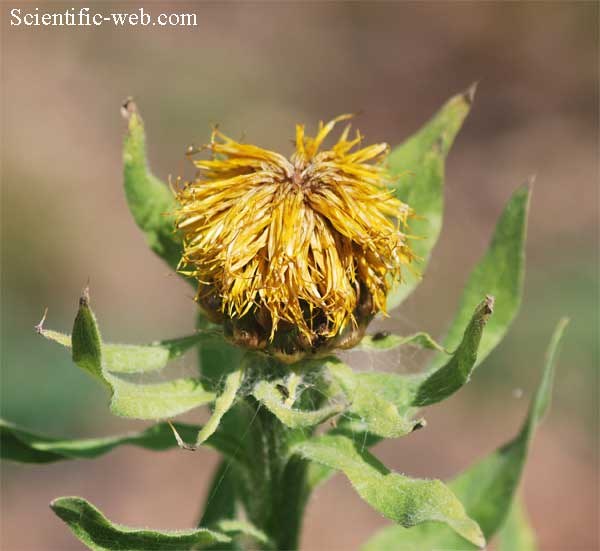
Centaurea macrocephala, Photo: Michael Lahanas
Classification System: APG IV
Superregnum: Eukaryota
Regnum: Plantae
Cladus: Angiosperms
Cladus: Eudicots
Cladus: Core eudicots
Cladus: Asterids
Cladus: Campanulids
Ordo: Asterales
Familia: Asteraceae
Subfamilia: Carduoideae
Tribus: Cardueae
Subtribus: Centaureinae
Genus: Centaurea
Species: Centaurea macrocephala
Name
Centaurea macrocephala Muss.Puschk. ex Willd., Sp. Pl., ed. 4, 3(3): 2298. 1803 [Apr-Dec 1803]
Synonyms
Homotypic
Grossheimia macrocephala (Muss.-Puschk. ex Willd.) Sosn. & Takht., Dokl. Akad. Nauk Armenii 3(1): 22. 1945.
Phaeopappus macrocephalus (Muss.-Puschk. ex Willd.) Boiss., Diagn. Pl. Orient. ser. 1, 6: 124. 1846 [1845 publ. Jul 1846]
Phaeopappus macrocephalus (Muss.-Puschk. ex Willd.) Freyn & Sint., Oesterr. Bot. Z. 44: 220. 1894.
Plumosipappus macrocephalus (Muss.-Puschk. ex Willd.) Czerep., Bot. Mater. Gerb. Bot. Inst. Komarova Akad. Nauk S.S.S.R. 20: 458. 1960.
Heterotypic
Phaeopappus paphlagonicus Bornm., Beih. Bot. Centralbl., Abt. 2. 59 Abt. B: 304, in adnot. 1939.
Distribution
Native distribution areas:
Continental: Asia-Temperate
Regional: Caucasus
Transcaucasus (Armenia, Azerbaijan, Gruzija, incl. Nakhichevan)
Regional: Western Asia
Iran (Iranian Aserbaijan), Turkey (NE-Anatolia).
References: Brummitt, R.K. 2001. TDWG – World Geographical Scheme for Recording Plant Distributions, 2nd Edition
References
Euro+Med 2006 onwards: Centaurea macrocephala in Euro+Med PlantBase – the information resource for Euro-Mediterranean plant diversity. Published online. Accessed: 2011 Sept 14.
Links
Hassler, M. 2018. Centaurea macrocephala. World Plants: Synonymic Checklists of the Vascular Plants of the World In: Roskovh, Y., Abucay, L., Orrell, T., Nicolson, D., Bailly, N., Kirk, P., Bourgoin, T., DeWalt, R.E., Decock, W., De Wever, A., Nieukerken, E. van, Zarucchi, J. & Penev, L., eds. 2018. Species 2000 & ITIS Catalogue of Life. Published online. Accessed: 2018 May 08. Reference page.
International Plant Names Index. 2018. Centaurea macrocephala. Published online. Accessed: May 08 2018.
The Plant List 2013. Centaurea macrocephala in The Plant List Version 1.1. Published online. Accessed: 2018 May 08.
Tropicos.org 2018. Centaurea macrocephala. Missouri Botanical Garden. Published online. Accessed: 08 May 2018.
USDA, ARS, Germplasm Resources Information Network. Centaurea macrocephala in the Germplasm Resources Information Network (GRIN), U.S. Department of Agriculture Agricultural Research Service. Accessed: 07-Oct-06.
Vernacular names
Deutsch: Großköpfige Flockenblume
suomi: Keltakaunokki
français: Centaurée à grosse tête
polski: Chaber wielkoglówkowy
Centaurea macrocephala is a species of flowering plant in the family Asteraceae, and a member of the thistle tribe, Cynareae. It has many common names, including bighead knapweed,[1] big yellow centaurea,[2] lemon fluff,[3] yellow bachelor's button,[4] yellow hardhat,[5] and Armenian basketflower.[6]
This plant is native to the Caucasus.[6] It is known throughout much of the world as an introduced species and sometimes a noxious weed.[6] It is a popular garden plant, and is widely available for cultivation as an ornamental.[6]
Description
This herbaceous perennial bears mostly unbranched stems reaching up to 170 cm tall. The leaves are variable in shape and size. Those near the base have oval blades borne on petioles and those higher on the plant have shorter, narrower blades. The flower heads are solitary atop the stems and have arrays of small leaves around the bases. The heads are 2.5 to 3.5 cm wide. The somewhat rounded head is covered in layers of phyllaries with fringed tips and sometimes spines. The head contains many yellow florets. The fruit, including its pappus, can be well over one centimeter long.[4]
Biology
In its native range in the Caucasus, this plant grows in mountain meadows. It is a summer-flowering subalpine species. It thrives as an introduced species in many types of moist temperate habitat, especially areas dominated by perennial herbs. It can grow in disturbed areas.[6]
Uses
This is a well-known ornamental flowering plant. It has been a garden flower for over 200 years, being introduced to the United Kingdom and United States in the early 19th century. Thomas Jefferson obtained seeds from the nurseryman Bernard McMahon and planted them at Monticello.[6]
In gardens it can be placed at borders or corners, where it will form clumps. It is used as a cut flower for its large, rounded heads with long yellow florets, and it can be used as a decorative dried flower.[5] This is the largest Centaurea in cultivation and is easily recognized.[6]
Ecology
As the plant has been transported around the world for ornamental use it has taken hold as an introduced species in several areas. It is a casual garden escapee in parts of Europe and North America. It has only become a troublesome noxious weed in a few areas, notably Washington state in the United States, where it is prohibited to buy or sell the species.[6] Its invasive nature is best seen in garden environments, where it is more aggressive than most other ornamental plants and can become a "garden thug".[6]
References
Centaurea macrocephala. USDA PLANTS. United States Department of Agriculture.
Centaurea macrocephala. Integrated Taxonomic Information System (ITIS).
Centaurea macrocephala. Invasive.org, Center for Invasive Species and Ecosystem Health.
Centaurea macrocephala. Flora of North America. eFloras.org
Centaurea macrocephala. Missouri Botanical Garden.
Centaurea macrocephala. Invasive Species Compendium. CABI.
Retrieved from "http://en.wikipedia.org/"
All text is available under the terms of the GNU Free Documentation License

